246 results
Biology simulations $5-10

CELLS CSI Investigation - Examining Plant and Animal Cells
*TOP SELLING ITEM*
In this lesson, students will be given a mystery to solve, based on their knowledge of cells. To solve the mystery, they need to know the major differences between plant and animal cells. Students apply their knowledge to a "real-life" scenario in which they must classify cells as plant or animal. Students will record their conclusions in a forensic lab report similar to one that could be used in court. This is an excellent activity for the end of a unit on plant and animal ce
Subjects:
Grades:
4th - 7th
Types:
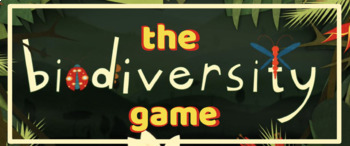
The Virtual Biodiversity Game
Students can use this Google form to make choices that determine how many species survive or go extinct in their ecosystem. Through 5 rounds, students are exposed to concepts such as biodiversity, biomes, climate, niches, pollution, and human impact. Students make choices and can see the impact it has on biodiversity (the number of species)This interactive activity is a great introduction to biodiversity. It is a great tool to get students thinking about what contributes to increased or decrease
Subjects:
Grades:
6th - 12th
Types:
NGSS:
MS-LS2-5
, MS-LS2-1
, HS-LS4-6
, MS-ESS3-4
, MS-ESS3-3
...
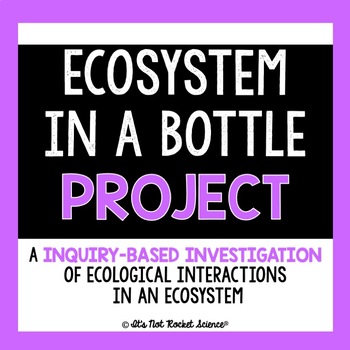
Ecosystem in a Bottle Project: An Inquiry-Based Ecological Investigation
In this inquiry-based lab investigation, students will create an ecosystem simulation using 2-Liter bottles to explore the cycling of the essential elements carbon, hydrogen, oxygen, and nitrogen through biotic and abiotic components of an ecosystem. Students will need a minimum of two 2-Liter bottles for this project – one to represent an aquatic ecosystem and one to represent a terrestrial ecosystem. Students will work with a partner to design a way to connect these two bottle ecosystems so th
Subjects:
Grades:
9th - 12th
Types:

Genetics and Heredity Lab: Celebrity Babies and Punnett Squares!
Come let's explore the world of genetics by creating Celebrity Babies! Students will use Punnett Squares and the concepts of heredity to become genetic counselors for some of the most popular celebrity couples of today! Included in this activity is: 1. Student Lab Worksheet2. Teachers' Guide3. Baby Templates4. Celebrity Couples (w/simulated genotypes)*Updated December 2022- New Celebrity Couples! 32 Celebrity Couples! Students LOVE this activity and will definitely leave your classroom with a
Subjects:
Grades:
5th - 12th, Higher Education, Adult Education
NGSS:
HS-LS3-3
, HS-LS3-1

Survival Games: An Fun, Adaptations-Based Challenge for the Evolution Unit
Explore the theory of evolution with your students as they create a creature that can survive a changing environment!Students will select from thirty two different adaptations, all with different survival perks, in order to design an organism that can (hopefully) survive drastic environment changes. In a Dungeons-and-Dragons-esque style, each adaptation provides points in certain categories of survival. My students become quickly enthralled with the challenge of picking just the right combinatio
Subjects:
Grades:
6th - 9th
Types:
Also included in: Biology Activities & Worksheets Bundle
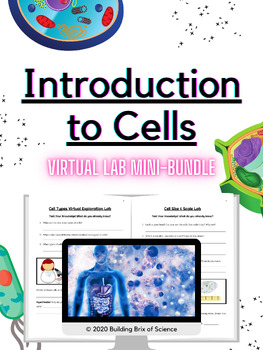
Introduction to Cells Virtual Lab Bundle
Get over 30% off each lab with the Introduction to Cells Virtual Lab Bundle! These four interactive lab assignments will help your students understand Living vs Nonliving Things, Cell Size, Cell Types, and Cell Organelles. Students will learn:Living or Nonliving?⚗️Test their pre-existing knowledge of the Characteristics of Life⚗️Compare and Contrast Living and Nonliving Things⚗️Label Items such as Feathers, Atoms, Bacteria, and Milk as Alive or Not Alive⚗️Explain why Viruses are not Living Thing
Subjects:
Grades:
5th - 10th
Types:
NGSS:
MS-LS1-2
, MS-LS1-1
, MS-PS1-1
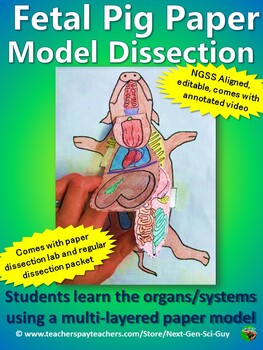
Fetal Pig Dissection: Paper Lab & Regular Lab - NGSS Aligned: Distance Learning
Body Systems and Organ – Fetal Pig Dissection This product comes with two versions of the Fetal Pig Dissection Lab: 1 paper model version, and 1 normal version (which would require you to purchase fetal pigs). It also comes with an answer key, and links to annotated videos of the dissection. In this activity NGSS (Next Generation Science Standards) aligned activity, students (Part 1:) complete a quick matching section for 11 organ systems, (Part 2:) Determine the gender of the pig, and age of th
Grades:
7th - 12th
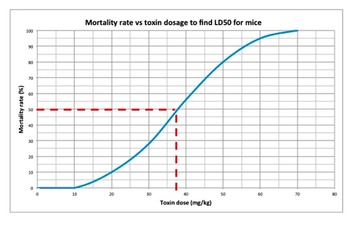
LD50 Simulation Lab w/Paper Mice - AP Environmental Science
In-depth guided inquiry investigation of LD50 (Lethal Dose 50%) appropriate for AP Environmental Science students. Set up once, use year after year. Instead of paying for and killing real animals (crickets, brine shrimp, daphnia, etc.), 'kill' some cartoon mice. In this lab, students collect data from mice exposed to various concentrations of 4 substances, calculate mortality %, predict and graph LD50 results, extrapolate to human dosages, answer thought-provoking questions, and complete practic
Subjects:
Grades:
9th - 12th
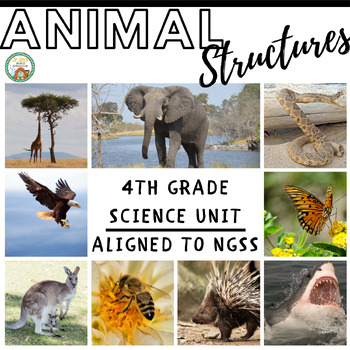
4th Grade Science: Animal Structures (NGSS Aligned)
This unit was designed specifically to address NGSS 4-LS1-1: Construct an argument that plants and animals have internal and external structures that function to support, survival, growth, behavior, and reproduction. This unit is appropriate for grades 3-5. Upper Elementary students learn about the structures animals have to help them with nutrition, self-defense, reproduction, and communication. Activities include:Activity 1: Animal Structures Sort: This introductory activity gets students fo
Subjects:
Grades:
3rd - 5th
Types:
NGSS:
4-LS1-1
Also included in: 4th Grade Science Plant and Animal Structures Bundle (NGSS Aligned)
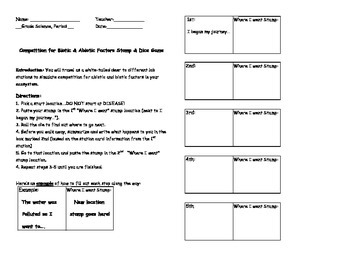
Competition for Biotic & Abiotic Factors Stamp & Dice Game
If you have played the Traveling Nitrogen Activity found at: http://www.windows2universe.org/teacher_resources/nitrogen_activity.pdf this game is exactly like that but modified for biotic and abiotic factors in an ecosystem.
Students will travel as a white-tailed deer to different lab stations to simulate competition for abiotic and biotic factors in an ecosystem.
Directions (from actual worksheet):
1. Pick a start location….DO NOT sta
Subjects:
Grades:
PreK - 12th, Higher Education, Adult Education
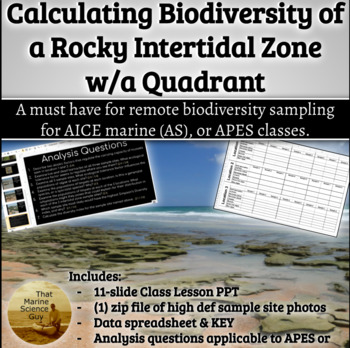
Marine Science Lab: Calculating Biodiversity of a Rocky Intertidal Zone
Product Description: Getting kids into the field is unfortunately not so easy all the time. This lab will bring the field to them. This activity (geared towards APES, AP Biology, or AICE marine students) will have your kids will examining photos from 3 seperate rocky intertidal zone ecosystems - here in Flagler county (see preview download above). The activity comes with a directions PPT, that also has tips on how to count all of the algae, and the dead barnacle shells, as well as how to identif
Subjects:
Grades:
9th - 12th, Staff
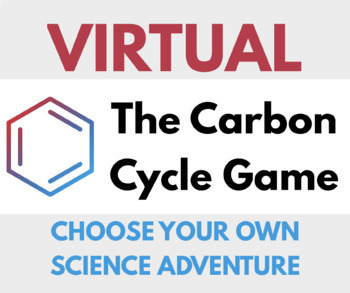
The Virtual Carbon Cycle Game
Students can use this Google form and virtual dice to play the role of a carbon atom moving through the Carbon Cycle. The probability of appearing in each carbon sink is modeled proportionally to Carbon Cycle in the real world. For example, the ocean is a large carbon sink and there is a high chance that students remain in the ocean for a few rounds in a row.The number of rounds played is up to the teacher, but throughout the game, students are exposed to concepts such as conservation of matter,
Subjects:
Grades:
9th - 12th
Types:
NGSS:
MS-ESS3-1
, MS-LS2-3
, HS-LS2-5
, HS-LS2-4
, MS-ESS3-5
...
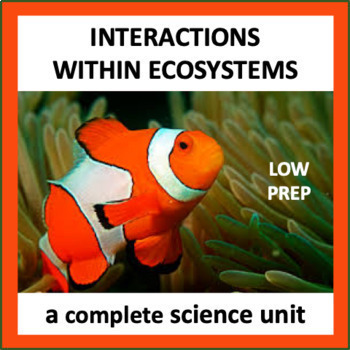
Interactions Within Ecosystems - a complete science unit
Interactions Within Ecosystems is a comprehensive science unit for middle years students with very little prep required by teachers. It is completely laid out with teacher notes and a sequence of activities. Students will learn about many ways in which organisms interact within an ecosystem. In this unit, students will learn about the following science concepts: organisms, biotic and abiotic things, individuals, populations, communities, species, interaction, habitats, ecosystems, microorganis
Subjects:
Grades:
5th - 8th
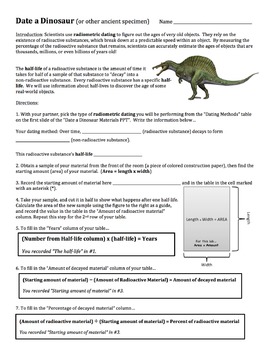
Date a Dinosaur Half-Life Activity
This activity allows students to work with the concepts of radioactive decay as it pertains to radiometric dating. Students use construction paper to model the radioactive decay of various substances, ultimately creating a graph that they use to date a variety of prehistoric specimens. This zip file includes 1. Teacher Directions Sheet, 2. Student Sheet, 3. PowerPoint
Subjects:
Grades:
7th - 9th
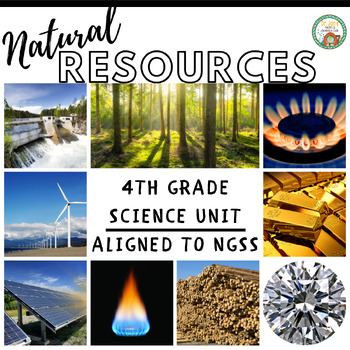
4th Grade Science: Natural Resources (NGSS Aligned)
This unit is designed to help students gain a solid understanding of natural resources and what they can do as responsible citizens to conserve non-renewable resources. This unit was developed to address NGSS 4:ESS3-1. It's appropriate for grades 3-6.If you are looking for a digital version of this product click here.Here's what's included in this unit:Activity 1: What is a Natural Resource?: Students watch an introductory video and then find natural resources within their own classroom. •Acti
Subjects:
Grades:
3rd - 6th
NGSS:
4-ESS3-1
Also included in: 4th Grade Science -NGSS- Entire Year Bundle

Protein Synthesis, Mutations & Modeling Hemoglobin Lab: NGSS - Distance Learning
In Brief: First, students read about protein synthesis, gene mutations, and chromosomal mutations. Then, students practice transcribing and translating mutated genes, identifying the type of mutation that occurred. Then, students read about protein structure, and put it all together using normal/sickle hemoglobin as an example. By comparing the change in amino acid sequence, students determine the cause of sickle hemoglobin, and construct origami models of the normal/sickle hemoglobin. Finally,
Subjects:
Grades:
7th - 12th

Crime Scene DNA Fingerprinting Lab with Key for Bar Codes
This is one of my favorite activities! The students really have a lot of fun with this lesson. After a brief talk about how the DNA in each of us is different, I relate that to how each food item has a different bar code as well. I use bar codes (DNA samples) and place them around my room on various objects. The students have to match the DNA sample (bar code) with the bar codes on their paper to see which perpetrator was at that particular crime scene. You can change the names on the bar code s
Subjects:
Grades:
4th - 10th
Types:
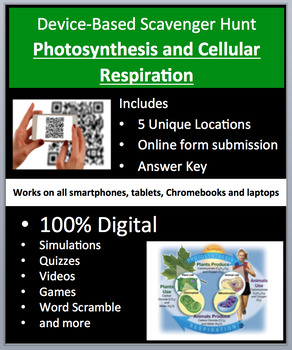
Photosynthesis and Cellular Respiration – Device-Based Scavenger Hunt Activity
Photosynthesis and Cellular Respiration - Device-Based Scavenger Hunt Activity. This activity is the coolest thing I've created and your kids are going to love it, mine do. Think of a scavenger hunt, then add devices (Smartphones, Chromebooks, Laptops, or Tablets), engaged students, and learning through assessment and you have this resource.Quick Disclaimer. In order to use this activity, your classroom must have at least 1 device per 3 students. Smartphones, Chromebooks, Laptops, and Tablets wi
Subjects:
Grades:
7th - 11th, Higher Education, Adult Education, Staff
Types:
Also included in: Mega Biology Resource Collection - Fully editable and growing bundle
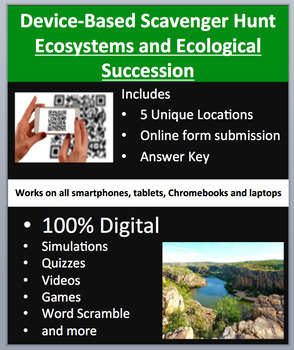
Ecosystems and Ecological Succession – A Device-Based Scavenger Hunt Activity
Ecosystems and Ecological Succession - A Device-Based Scavenger Hunt Activity. This activity is the coolest thing I've created and your kids are going to love it; mine do. Think of a scavenger hunt, then add devices (Smartphones, Chromebooks, Laptops, or Tablets), engaged students, and learning through assessment and you have this resource.Quick Disclaimer. In order to use this activity, your classroom must have at least 1 device per 3 students. Smartphones, Chromebooks, Laptops, and Tablets wil
Subjects:
Grades:
7th - 11th, Higher Education, Adult Education, Staff
Types:
Also included in: Mega Biology Resource Collection - Fully editable and growing bundle
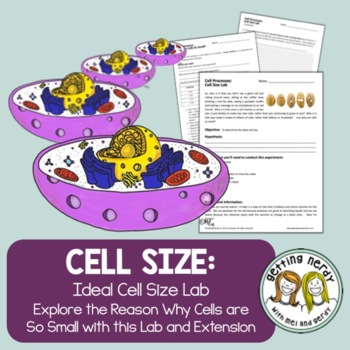
Cells - Cell Size Lab PowerPoint & Handouts
Cells - Cell Size Diffusion and Math Lab Why are cells so small? This integrated math lab allows students to experiment with various "cell" sizes to determine the ideal cell size. Lab activity includes lots of measurements and calculations to demonstrate why the ratio of surface area to volume is so important with respect to cells. Great demonstration lab or a challenging individual or group lab for higher level learners and differentiated grouping.• DIGITAL GOOGLE CLASSROOM links to all items
Grades:
5th - 10th
Types:
NGSS:
MS-LS1-2
, MS-LS1-1
Also included in: Cell Processes - PowerPoint & Notes, Labs, Activities, & Projects
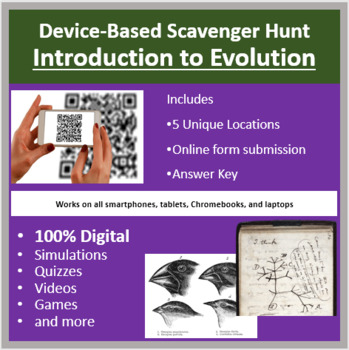
Introduction to Evolution – A Digital Scavenger Hunt Activity
Introduction to Evolution - A digital, device-based resource that will get your kids out of their seats, engaged, utilizing technology, and collaborating to solve real problems and test their knowledge. This activity works well across grades as a means of assessment, review, and/or instruction. This hunt was designed for middle/high school biological science students.This activity is the coolest thing I've created and your kids are going to love it; mine do. Think of a scavenger hunt, then add d
Grades:
7th - 12th, Higher Education, Adult Education, Staff
Types:
Also included in: Mega Biology Resource Collection - Fully editable and growing bundle
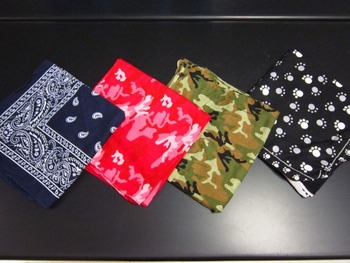
Symbiosis Activity/ Simulation & Limiting Factors
This original activity may be used as an introduction or review of
Symbiotic Relationships and Limiting Factors.
In this activity, students will be paired together with a partner to simulate several types of symbiotic relationships. Organisms (students) will try to fulfill their requirements for life: food, water, living space, and shelter (limiting factors). The scoring system for each symbiotic relationship is different to simulate the benefits and deterrents of each relationship. Points
Subjects:
Grades:
7th - 10th
Types:

Biodiversity – A Digital Scavenger Hunt Activity
Biodiversity - A Digital, Device-Based resource that will get your kids out of their seats, engaged, utilizing technology, and collaborating to solve real problems and test their knowledge.This activity is the coolest thing I've created and your kids are going to love it, mine do. Think of a scavenger hunt, then add devices (Smartphones, Chromebooks, Laptops, or Tablets), engaged students, and learning through assessment and you have this resource.Quick Disclaimer. In order to use this activity,
Subjects:
Grades:
7th - 11th, Higher Education, Adult Education, Staff
Types:
Also included in: Mega Biology Resource Collection - Fully editable and growing bundle
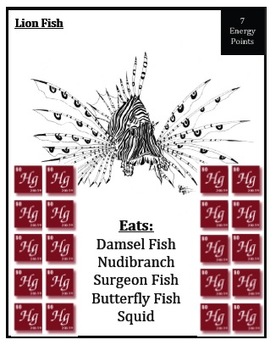
The Coral Reef Food Web -Including Invasives, Extinction and Biomagnification
With this activity students will:
1. Construct a food web of reef organisms using cards representing those organisms. Marked on the animal cards is also energy points and mercury levels of each organism.
2. Construct a numbers pyramid, energy pyramid and bioaccumulation pyramid based on their original food web.
3. Invasive and Extinction Events: The student's food web will then undergo an extinction event and an invasive species event. Students will reconstruct their food webs with this new
Subjects:
Grades:
8th - 12th
Types:
Showing 1-24 of 246 results





